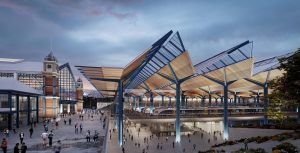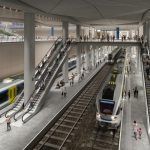 Budapest Development Agency (BFK) announced that a consortium led by Grimshaw Architects won the international architectural competition for the renewal of Budapest Nyugati railway station (the Western Railway Station) and its area.
Budapest Development Agency (BFK) announced that a consortium led by Grimshaw Architects won the international architectural competition for the renewal of Budapest Nyugati railway station (the Western Railway Station) and its area.
The consortium includes Nautes Architects from Budapest, WSP Global Engineering, Vogt Landscape Architects from Zurich and Turnet & Townsend, a project management company based in Leeds.
The Nyugati railway station project includes the construction of a new 13-track two-storey station with a new hall, the construction of an underground 8-track station which will also be able to receive the trains coming from Buda in the planned Danube railway tunnel, a new linear park in the densest downtown area parallel to the tracks and a station area urban master plan. The project also covers the refurbishment of the plaza in front of the station with the elimination of the current road bridge and surface parking, creating new green areas and a pedestrian plaza.
The upgrade of the railway line leading to the new station will increase the frequency of trains, and the quality of services and transfers in the station will make rail transport more competitive. All the public spaces around the railway station will be upgraded, and the linear public park will be created on the site of Nyugati tér and the rust belt along the railway, connecting the Nagykörút with the Városliget and later the Rákosrendező area. The most valuable, now dead or decaying areas of Budapest will be given a new lease of life with sustainable transport, lots of greenery, and the healing of the wounds and gaps that are an eyesore in the middle of the city.
The renewal and modernisation of Nyugati train station is essential for suburban and long-distance train traffic as well as for the new airport connections which will double the capacity of the station.
In 2021, BFK shortlisted 12 architect teams out of the 36 applicants for the Budapest Nyugati Railway Station design contest. During the tender procedure, two other companies have received the second prizes in the competition announced by BFK last October and includes the office of Albert Wimmer (Austria) and AREP Architects, a subsidiary of SNCF Gares & Connexions.The consortium of Zaha Hadid Architects and Finta és Társai Architects Studio won the 3rd place and the jury also bought the project of the Japanese-Hungarian duo Kengo Kuma & Associates + M-Teampannon.
Budapest’s current rail network is maxed out, and its main terminal stations, the Nyugati, Keleti and Déli, cannot accommodate and turn any more trains. The only realistic way to increase capacity is to convert head terminals into through systems. A through track can service six times as many trains as a terminal track, because its trains do not have to be backed out but can carry on and followed by the next one in two or three minutes.
The project is part of the EUR 10 billion Budapest Suburban Railway Node strategy approved by the Hungarian government in December 2021.
Share on:









